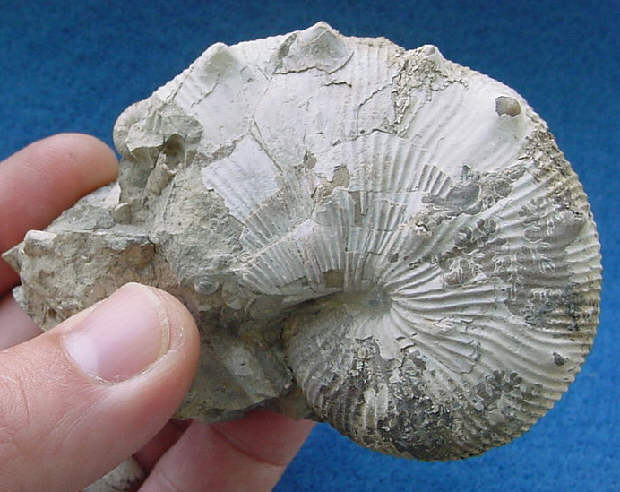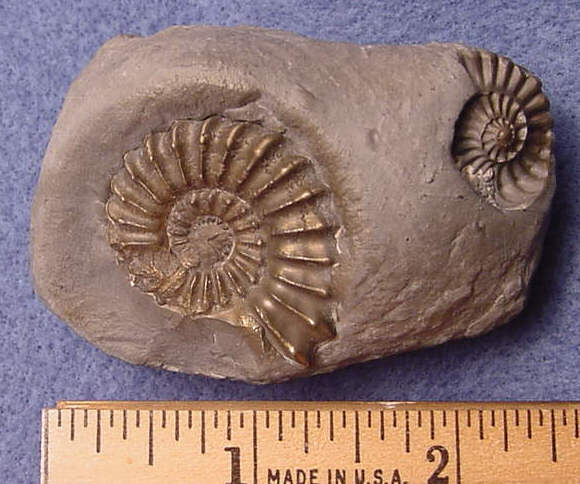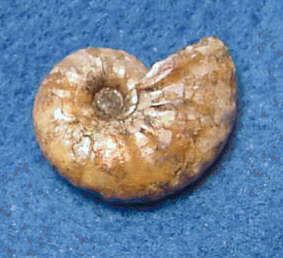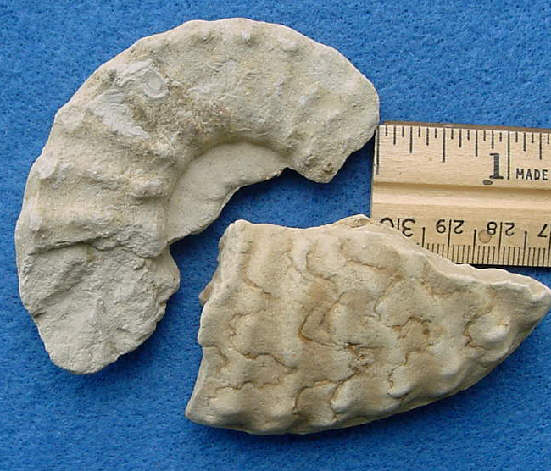

Cephalopods are tentacled mollusks that include living forms such as squids, cuttlefish, and octopi. In the prehistoric past many additional forms also existed, including many species of nautiloids (which includes a living representative, the chambered nautilus), and an all-extinct group, the ammonites. Most ammonites and nautiloids had coiled shells, but some nautiloids had straight shells. Both groups had multi-chambered shells--adding more chambers as they grew, always living in the outer chamber.
This auction features eight different fossils representing ammonites and nautiloids from various localities and geologic periods. The photo at left shows all the whole collection. The photos below are close-ups of the individual specimens, which descriptions as follows:
(Row 1, left). The first specimen is an ammonite over 3 inches long, of the species Acanthoscaphites nodosus. It comes from the late Cretaceous Pierre Shale formation of Dawson County, Montana, approx. 80 million years old. It is largely complete and shows much of the original shell, plus a section showing the lacey sutures between the champers. It also contains a small ammonite near the shell opening, where it is still attached to some of the original shale matriz.
Row 1, Middle). This is another Upper Cretaceous ammonite: a well-preserved Discoscaphites conradi from the Fox Hills Formation of South Dakota, approx. 70 million years old. It is about 2 inches long, on the original grey matrix, and exhibits some beauutiful green and pink pearlescence or "nacre" on the shell (the colorful sheen shows much nicer in person).
(Row 2, Right). This is a Pleuroceras spinatum, a pyritized ammonite from the Lower Jurassic Lias Formation of Unterstuermig West Germany, approx. 195 million years old. Included is the same rock is a nice impression of a smaller Pleuroceras fossil.
(Row 3, Left, tan specimen) This is a segment of a straight nautiloid cephalopod called Orthoceras from the Middle Ordovician Cincinnatian rock group of Ohio, approx. 470 million years old. On the same matrix are a number of bryozoan ("moss animal") fossils.
(Row 3, Left, grey specimen). This is a section of a larger middle Ordovician Orthoceras straight cephalopod from southern Ohio.
(Row 3, Center). This is a cute little Discoscaphites of the Cretaceous Fox Hills formation of South Dakota, showing several of the chambers eroded open on one side, and showing colorful, shimmering nacre of the intact shell on the other side.
(Row 3, Right). The last two specimens are segments of lower Cretaceous ammonites, probably Schloenbachia, from the Duck Creek formation of Grayson Co., Texas, approx. 110 million years old. One shows nice indications of the suture lines between the chambers.
Row 4. Close-up of Acanthoscaphites showing sutures.
All 8 fossils come with identification labels. Low starting bid and no reserve. Buyer to pay 4.50 shipping in the United States (add 1.00 for insurance of Priority Mal). Thank you.





